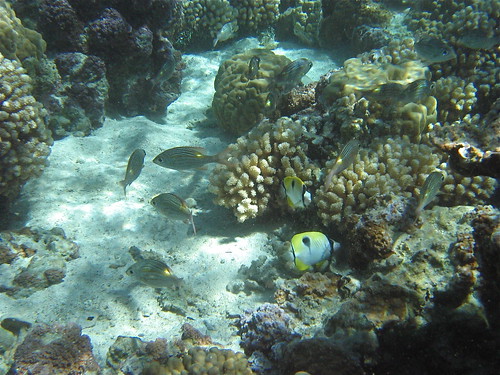It's not a joke and here is the story: we just spent a week in the paradisiac island of
Bora-Bora and on the very first day of our stay, we were lucky to attend a small wine tasting event. Surprisingly, the tasting was about Polynesian wine.

Making wine in French Polynesia seems like a crazy idea but that was a
dream that entrepreneur Dominique Auroy was able to realize after a decisive meeting with
Bernard Hudelot, a viticulturist in Burgundy and professor at the University of Dijon.
It took several years of research to successfully grow vines in French Polynesia. The project started in 1992 when the first grapevines were brought from Europe to Polynesia where they faced many challenges including weather and soil acclimation, and problems associated with high humidity, diseases and insects. Different locations and soil types were tested for the project. At the end, the best growing conditions were found in atolls thanks to their coral-rich soils and salty sea breezes.
Today, the wine is produced on the atoll of
Rangiroa, 355 km (220 miles) from
Tahiti, the main island of French Polynesia. The
vineyard is located on a motu (or small islet), in the middle of a coconut grove, between a tropical lagoon on one side and the Pacific ocean on the other side. Because there is no cold season and no latency period, there are two harvests per year. The grapes are brought to the winery on the main island by boat.
More than thirty different grape varieties have been tested in order to identify which ones would successfully adapt to the particular soil and climate of the island. At the end, only three varieties were selected: Carignan, Black Muscat or Muscat de Hamburg, and Italia, a Muscat-derived white variety. These three are now used to respectively produce a red, rosé, and white wine.
Honestly, this is an interesting story but I was not convinced by the Polynesian wine. The white, which I think was the best of the lot, was rather dry, aromatic, lacking acidity on the palate, but overall pleasant. The rosé had an intense fruity nose with aromas of strawberry candy and a rather soft palate. The red was obviously oxidized and not really drinkable. Maybe the bottle had been exposed to heat or maybe this was what the wine was supposed to taste.
On the other hand,
Hinano, the beer from Tahiti was absolutely delicious, especially after a snorkeling trip to the coral garden!
 Technorati tags: wine food & drink
Technorati tags: wine food & drink

 2006 Ridge Zinfandel Ponzo Vineyard: 95% Zinfandel, 5% Petite Sirah from the Ponzo Vineyard in the Russian River Valley. The Russian River Valley's cooler microclimate ripens this wine shortly after Lytton Springs and Geyserville. Berry on the nose, nice complexity on the palate, long earthy finish.
2006 Ridge Zinfandel Ponzo Vineyard: 95% Zinfandel, 5% Petite Sirah from the Ponzo Vineyard in the Russian River Valley. The Russian River Valley's cooler microclimate ripens this wine shortly after Lytton Springs and Geyserville. Berry on the nose, nice complexity on the palate, long earthy finish.

